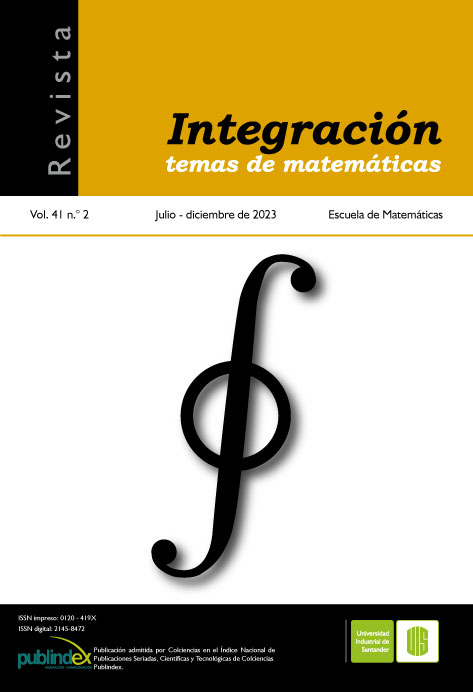Artículos científicos
Publicado 2023-09-06
Cómo citar
García Lomelí, A. C., & Hernández Hernández, S. (2023). Los números de Padovan de la forma 6a ± 6 b ± 6 c. Revista Integración, Temas De matemáticas, 41(2), 69–81. https://doi.org/10.18273/revint.v41n2-2023001
Derechos de autor 2023 Revista Integración, temas de matemáticas

Esta obra está bajo una licencia internacional Creative Commons Atribución 4.0.
Resumen
Sea (Pn)n>0 la sucesión de Padovan dada por P0 = 0, P1 = P2 = 1 y la fórmula de recurrencia Pn+3 = Pn+1 + Pn para todo n > 0. En esta nota, resolvemos completamente el Diofántico ecuación Pn = 6a ± 6b ± 6c en números enteros no negativos (n, a, b, c) con a > b > c > 0.
Descargas
Los datos de descargas todavía no están disponibles.
Referencias
- A. Baker, H. Davenport, The equations 3X^2 − 2 = Y^2 and 8X^2 − 7 = Z^2 , Quart. J. Math. Oxford (20) (2), 129–137, 1969.
- Y. Bugeaud, M. Mignotte, S. Siksek, Classical and modular approaches to exponential diophantine equations I: Fibonacci and Lucas perfect powers, Ann. of Math. 163, 969–1018, 2006.
- J. J. Bravo, C. A. Gomez, F. Luca ´ , Powers of two as sums of two k-Fibonacci numbers, Miskolc Math. Notes (17) (1), 85–100, 2016.
- A. Dujella, A. Petho, A generalization of a theorem of Baker and Davenport, Quart. J. Math. Oxford (49) (3), 291–306, 1998.
- S. Guzman Sánchez, F. Luca ´ , Linear combinations of factorials and S-units in a binary recurrence sequence, Ann. Math. Quebec (38), 169–188, 2014.
- S. Hernandez Hernández ´ , The Fibonacci numbers of the form 2a ± 2 b + 1, Fibonacci Quart. (56) (4), 354–359, 2018.
- S. Laishram, F. Luca, Fibonacci numbers of the form x a ± xb ± 1, Fibonacci Quart. (52) (4), 290–295, 2014.
- F. Luca, S. Pantelimon , Fibonacci numbers of the form p a ± p b . Proceedings of the Eleventh International Conference on Fibonacci Numbers and their Applications, Congr. Numer. (194), 177–183, 2009.
- F. Luca, L. Szalay, Fibonacci numbers of the form p a ± p b + 1, Fibonacci Quart. (45) (2) 2007, 98–103, 2008.
- E. M. Matveev, An explicit lower bound for a homogeneous rational linear form in the logarithms of algebraic numbers II, Izv. Math. (64) (6), 1217–1269, 2000.
- N.J.A. Sloane, The On-Line Encyclopedia of Integer Sequences, https://oeis.org/
- L. Szalay, The equations 2^N ± 2^M ± 2^L = z^2, Indag. Mathem., N. S. (13) (1), 131–142, 2002.

